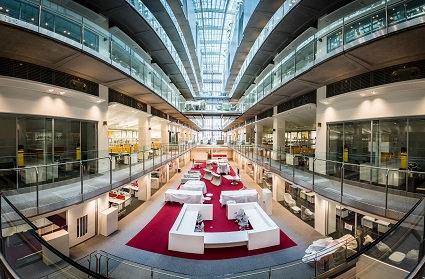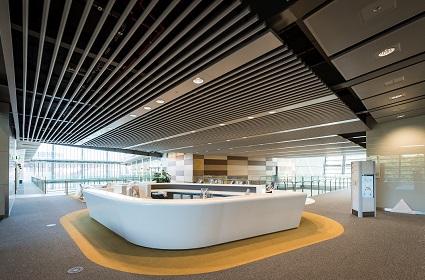Science begins in the Crick
 The first scientists have moved into the new £650 million Francis Crick Institute building in London and are starting work in their purpose-built labs. Next to St Pancras station and the British Library, the Crick will be the biggest biomedical research institute under one roof in Europe.
The first scientists have moved into the new £650 million Francis Crick Institute building in London and are starting work in their purpose-built labs. Next to St Pancras station and the British Library, the Crick will be the biggest biomedical research institute under one roof in Europe.
Research groups will continue moving in each week until the end of the year, as lab space is adapted for each research group. The start of 2017 will see the Francis Crick Institute up and running with all 1250 scientists and 250 other staff moved in and research projects ramping up.
Researchers from the Faculty of Life Sciences & Medicine seconded to the Crick will be taking up residence there in the coming months:
Patricia Barral, Immunology, Infection & Inflammatory Disease
Patricia's research aims to understand the cellular and molecular mechanisms that underlie the initiation of immunity and how those contribute to human health and disease. Her group specifically focus on immune responses to lipids (both endogenous and from microbes) exploring how the immune system handles lipids, which are the mechanisms that mediate lipid recognition by immune cells and which are the consequences for human health when these processes are dysregulated. Read more.
Jeremy Carlton, Cancer Studies
Jeremy is interested in the basic biology of cells in the human body. His current research is focused on the cell’s internal membranes and how they are shaped and distributed during cell division (mitosis). He is trying to understand how the nuclear envelope (or the nuclear membrane) is broken down at the start of mitosis, how components of the envelope are separated into daughter cells, and how these components are rebuilt as mitosis progresses. Mitosis is essential for growth and development and understanding the basic mechanisms underlying mitotic biology provides a deeper understanding of the deregulation of cell division in disease. Read more.
Francesca Ciccarelli, Cancer Studies
Francesca's research group aims to understand the role of genetic alterations in human cancer using a combination of computational and experimental approaches. Their research builds upon the idea that, although genes involved in cancer development (cancer genes) differ functionally, they share intrinsic properties that are not visible when studying each gene individually. We thus engaged in a systems-level analysis of cancer genes in the context of gene and network evolution. We showed that cancer genes encode highly connected and central proteins of the protein-protein interaction network. Read more.
Snezhana Oliferenko, Cell & Molecular Biophysics
Snezhana's research group study how cells establish polarized states and navigate the mitotic division. These processes require a defined intracellular organization that is robust across a variety of environmental conditions. Yet, it shows a remarkable plasticity as cells progress through the cell cycle and respond to the extracellular cues. This balance between order and plasticity is at heart of cellular physiology. Its disruption has severe physiological consequences and could lead to developmental defects and disease. Read more.
More information on their work can be found here.
About the Francis Crick Institute
Research at the Crick aims to discover how and why disease develops in order to find new ways to prevent, diagnose and treat conditions such as cancer, heart disease and stroke, infections and neurodegenerative conditions like motor neurone disease.
The Crick has been established through the collaboration of six founding partners: the Medical Research Council (MRC), Cancer Research UK, Wellcome, UCL (University College London), Imperial College London and King’s College London.
The institute is bringing scientists together from across disciplines to tackle the pressing health concerns of the 21st century. By being open to collaboration, by training future science leaders and by seeking to improve people’s health and wellbeing, the Crick aims to boost UK science and health and help drive the UK economy.
Professor Edward Byrne AC, President and Principal of King’s College London, says: “As a founding academic partner King’s is delighted to play a key role in this world-leading institute, bringing experts from a wide range of disciplines to work collaboratively under one roof. King’s has an excellent track record in bringing scientists and clinicians together to translate research into innovative treatments as quickly as possible. Our expertise will strengthen further the institute’s ability to bring basic and applied science together with clinical knowledge, to benefit patients across the UK as well as society as a whole.”
The building
The Crick’s building is one of the most complex buildings in London. It has been designed by architects HOK with PLP Architecture and constructed by Laing O’Rourke. Arup and AKT II were the engineers on the project, with Arup also the project manager. Turner & Townsend were cost consultants on the project and Cordless Consultants have provided IT and AV facilities.
The design, construction and commissioning of the 170m-long building with approaching 1 million square feet of floor space over 12 floors has been a technically challenging undertaking and an engineering project in itself. It required very high specifications to be met for the most sensitive and advanced research equipment to be used – such as high vibration resistance, close temperature control, minimisation of electromagnetic interference and high rates of air change. The building has also been designed to minimise impact on the environment, with solar panels on the roof and its own combined heat and power system. The energy-saving features should reduce the energy bill by a third and the building has been given an ‘excellent’ BREEAM rating.

The approach
On 1 April 2015 the Medical Research Council’s National Institute for Medical Research and Cancer Research UK’s London Research Institute merged to become the Francis Crick Institute. These research groups are being joined by scientists from the university partners (UCL, Imperial and King’s), who bring with them specialist knowledge, skills and resources across a range of scientific disciplines. In particular, university researchers working in the Crick help add expertise in the physical and clinical sciences.
Collaboration and interdisciplinary working is designed in to the Crick. Research groups from different disciplines and from different original organisations have been given neighbouring lab space. Coupled with lots of open work space, breakout areas and shared core facilities, this means scientists can’t help but bump into each other, have conversations and share ideas. It is all expected to lead to the generation of new insight, research directions and innovations.
The new building is equipped with state-of-the-art facilities for biomedical research. Genetics and genomic studies have access to advanced DNA sequencing, while the latest mass spectrometry equipment allows gene expression, proteins and metabolic pathways to be characterised. Bioinformatics support allows studies involving very large datasets. The robots in the high-throughput screening facility allow tens of thousands of drug candidates to be tested in cells. Electron microscopy, X-ray crystallography and nuclear magnetic resonance suites allow biological structures to be studied in fantastic detail.
The Crick specialises in discovery science: investigating the fundamental biological processes underlying human health and disease. But the increased understanding of these key processes can lead to opportunities to develop novel drugs and innovative new treatments. Translational research – the turning of biological discoveries in the lab into treatments for patients in the clinic – will be a focus for the Crick. For example, the institute has an ongoing partnership with GSK in which teams of scientists from both organisations work side by side in the lab and benefit from the sharing of ideas and approaches in investigating biological systems.
Paul Nurse, Director of the Francis Crick Institute, said: “A remarkable state-of-the-art new home for the Crick has been completed and the occupation by scientists has started. But this is only the beginning. As all our research groups move in over the rest of the year, it will be the discoveries we make here that will establish our place at the forefront of science in London, the UK and worldwide.”
David Roblin, Chief Operating Officer and Director of Scientific Translation at the Francis Crick Institute, said: “It is tremendous to have reached the point when science is beginning in our glorious new building. It’s been an achievement of many people to this point – in the design, the construction, the fitting out, and the project management of moving in people, equipment and experiments. To do this while also running active research programmes across multiple sites speaks to the skill and effort of our staff and supporters. It gives a sense of what we’ll be able to achieve once we’re all together in our new home.”
Notes to editors:
For more information, please contact the King’s College London press office on 020 7848 3202, pr@kcl.ac.uk.